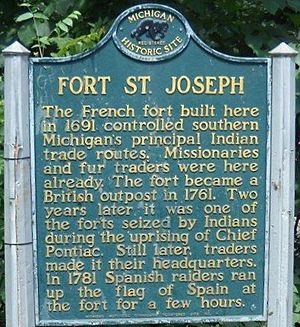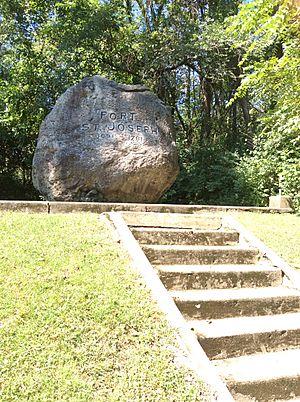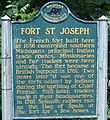Fort St. Joseph (Niles, Michigan) facts for kids
Quick facts for kids Fort Saint Joseph |
|
|---|---|
| Fort Saint Joseph | |
| Niles, Michigan | |

Fort St. Joseph marker
|
|
| Coordinates | 41°48′49″N 86°15′44″W / 41.813675°N 86.262288°W |
| Site history | |
| Built | 1691 |
| Built by | French |
| In use | Fur Trade Post |
| Demolished | 1795 |
| Battles/wars | American Revolution |
| Events | Pontiac's Rebellion, Raid of 1780 and Raid of 1781 |
|
Fort St. Joseph Site (20BE23)
|
|
| Location | Niles, Michigan |
| NRHP reference No. | 73000944 |
| Significant dates | |
| Added to NRHP | May 24, 1973 |
Fort Saint Joseph was an important fort built by the French. It was located in what is now Niles, Michigan. The fort was first a mission called Mission de Saint-Joseph. A Jesuit priest named Père Claude-Jean Allouez started it in the 1680s. He worked with the local Odawa and Ojibwe Native American tribes.
The French built the fort in 1691. It was a trading post on the lower Saint Joseph River. The fort was placed where a major Native American trail, the Old Sauk Trail, crossed the river. This made it a key spot for the fur trade at the southern end of Lake Michigan. Before the French and Indian War, about 10 French soldiers and other people lived there. This included a commander, a blacksmith, and a Catholic priest.
After the French and Indian War, the British took control of the fort. They used it to trade furs. During the American Revolutionary War, the British supplied their Native American allies from this fort. In 1781, the Spanish briefly raided the fort. They even claimed the area as their own. The British kept the fort until 1795. This was after the United States won the Northwest Indian War and signed Jay's Treaty. After the British left, the fort slowly fell apart and was covered by forest.
The fort site was lost for many years. It was only found again in 1998. Since 2002, archaeologists have been digging there. They have found rare items, like a Jesuit religious medallion from the 1730s. It is one of only two found in North America. In 2010, they found a foundation wall and corner posts of an original building. The site is now listed on the National Register of Historic Places. It is also a state-registered site.
Contents
Fort Saint Joseph and the French and Indian War
The French and Indian War was a big conflict between Britain and France. It happened in North America. After Britain won this war, France gave Fort St. Joseph to the British. The British officially took over the fort in October 1761.
Fort Saint Joseph and Pontiac's Rebellion
On May 25, 1763, during Pontiac's Rebellion, Potawatomi warriors attacked the fort. Pontiac's Rebellion was a fight by Native American tribes against British rule. The warriors captured Fort St. Joseph. They killed most of the 15 British soldiers. The fort's commander, Ensign Francis Schlosser, was taken prisoner. He was later traded for money in Detroit.
After Pontiac's Rebellion ended, the British kept the fort as a trading post. But they did not put soldiers there again until 1779. This was during the American Revolutionary War.
Fort Saint Joseph During the American Revolution
During the American Revolution, the British used Fort St. Joseph to help their Native American allies. These allies included the Miami and Potawatomi tribes. They fought against the American colonists.
Raid of 1780
In 1780, Americans from Cahokia, Illinois, attacked the fort. They were led by Jean-Baptiste Hamelin and Lt. Thomas Brady. The British Lt. Dagneaux Du Quindre chased them. He caught and defeated the American raiding party near Petit Fort in present-day Indiana.
Spanish Expedition of 1781
After the American raid failed, two Native American chiefs from Milwaukee asked for help. They went to Spanish-controlled St. Louis. Don Francisco Cruzat, the leader in St. Louis, sent Captain Don Eugenio Pouré. He led 60 volunteers and Native American allies.
This Spanish and Native American force traveled a long way. They reached Fort St. Joseph on February 12, 1781. They surprised the fort by crossing the frozen river quickly. Captain Pouré captured the fort before the British could fight back. He raised the Spanish flag. He claimed Fort St. Joseph and the St. Joseph River for Spain. His troops took goods from the fort for one day. They shared these goods with the Native Americans. Then they left. Lt. Dagneau de Quindre arrived the next day. But he could not convince his Native American allies to chase the Spanish. The Spanish returned to St. Louis safely on March 6.
Some historians say this attack was a Spanish response. It was for a British attack on St. Louis the year before. The Spanish leader, Cruzat, said he needed to show strength to his Native American allies. He also wanted to stop future British attacks.
Jay's Treaty and the Fort's End
The British finally left Fort St. Joseph after the United States won the Northwest Indian War. This happened after Jay's Treaty was signed in 1795. The fort then slowly fell into ruin. Spain had claimed lands east of the Mississippi River because of their raid on Fort St. Joseph. But the United States did not agree with this claim. Spain gave up all claims to land east of the Mississippi when they signed Pinckney's Treaty in 1795.
Some American diplomats, like Benjamin Franklin and John Jay, thought the Spanish raid was just a trick. They believed Spain wanted to claim the Northwest Territory. Franklin worried they wanted to "shut us up within the Appalachian Mountains."
Rediscovery and What's Happening Now
In the late 1800s, people looking for old items found hundreds of artifacts at the fort site. These items are now shown at the Fort St. Joseph Museum in Niles. They include old silver, gun parts, glass beads, and buttons. The exact spot of the 15-acre fort was forgotten for a long time. Part of it might even be underwater now because a dam raised the river's water level.
The site was rediscovered in 1998 during an archaeological survey. A local group called "Support the Fort" helped start a major archaeological dig in 2002. A team from Western Michigan University (WMU) runs a public archaeology program. About 10,000 visitors have come to their annual two-day field school. WMU also offers workshops for students and teachers. They give lectures at the local library.
The digs each season have found rare items. One is a Jesuit religious medallion from the 1730s. It is one of only two found in North America. In December 2010, the team made a big discovery. They found a foundation wall and two wooden posts from one of the original buildings. This helps them understand how big the fort was.
"Support the Fort" also organizes yearly living history events. These events show what life was like at the fort. They feature people dressed as Potawatomi, French, British, and American residents. In the future, they plan to build a replica of the fort. This new fort will have space to show the artifacts found. Fort St. Joseph was the only fort in Michigan to be under four flags: France, Great Britain, Spain, and the United States. It was always a place where different cultures met and traded. This included Europeans and the Potowatomi, Ottawa, and Ojibwe nations.
Images for kids






